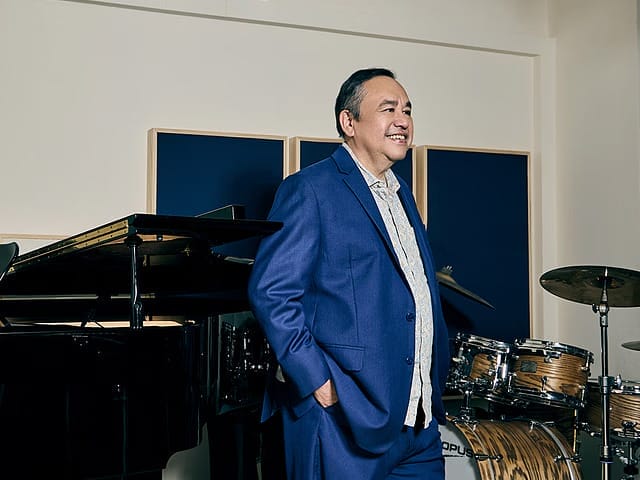by Zat Astha

Photo: Veronica Tay
As you read this story about maestro Jeremy Monteiro, I feel it apt, nay, mandatory, to have “Montage: Concerto for Jazz Piano & Orchestra” composed by the eminent Dr Kelly Tang, playing in the background. Several versions are floating around the internet, but my favourite will always be the rendition by Singapore Symphony Orchestra performed during the group’s National Day Concert in 2019, with Monteiro leading the ensemble through the three-movement piece.
Still, this story is not about my fascination with and reverence for the King of Swing. Instead, my conversation with Monteiro turned out to be one of reflection. “I’ve had a few moments in my musical journey where I lost interest and fell out of love with music, Zat,” he shares. “I worked too hard and lost some of the sparkle.”


It was like falling in love with music all over again — he even composed a tune to commemorate that feeling. “Some people speculated that Falling In Love Again was about a new romantic relationship, but in reality, it was about rediscovering my love for music,” Monteiro shares.
Jazz Association (Singapore)


Photo: Veronica Tay
I’m also here to speak to Monteiro about the Jazz Association (Singapore) (JASS), which he founded in September 2016 to promote jazz’s excellence, participation, and engagement in Singapore.
This year marks JASS’ 7th anniversary, which will be commemorated by the JASS Benefit Gala. Guests will be treated to a performance by two-time Grammy Nominee Roberta Gambarini, who will perform alongside the Jazz Association Singapore Orchestra (JASSO) led by Monteiro.
His original goals were to “elevate the level of excellence in jazz, expand the audience, and attract those new to jazz”. “For example, with our Jazzed Up series,” Monteiro shares, “we reached out to Chinese music fans who may not typically listen to jazz but were interested in hearing their favourite melodies performed in a jazz style. We also collaborated with Malay artists like Ramli Sarip, Rahimah Rahim, and Rudy Djoe, arranging their tunes in a jazz format.”
The JASS has since achieved many other milestones, such as establishing scholarship programs and initiating the Jazz Crisis Fund, which helped musicians facing financial difficulties during the COVID-19 pandemic.
In search of Singaporeana
When not busy promoting or performing for JASS, Monteiro is on a contact quest to tweak the sounds of Singaporeana — a distinct Singaporean sound similar to how Norway, Sweden, and even Germany have carved out their unique Jazz styles.
“Singapore, with its diverse racial makeup of Western, Malay, Chinese, and Indian influences, has the potential to create such a sound,” he explains when I ask why the Singaporean sound identity is essential.






“While there have been successful fusions of jazz with Indian and Chinese music separately, we possess a unique opportunity to blend these influences together and create something truly Singaporean.”
He tells me that a recent experiment with the JASSO Ethno-Jazz Ensemble, and Jazz Ensemble led to a breakthrough. “We felt we had finally achieved a distinct Singaporean sound, akin to the American sound associated with Copland called Americana. It was a significant milestone, and I hope others will join us in further exploring this direction.”
Silence and stillness
In a world where AI is on a meteoric rise, social media has shortened everyone’s attention, and climate change is proving to be a polarising issue, it may be hard to understand where Monteiro finds the inspiration and positivity to put music on such a hopeful pedestal.
“You are right in observing that social media, the modern world, and technology have diminished our attention span to that of a battle,” he elaborates. “However, I believe the key to a fulfilling life lies in striking a balance between stillness and motion.”
For instance, Monteiro tells me that meditation quiets the mind and fosters inner tranquillity. Motion, on the other hand, entails being dynamic and active. “Both elements contribute to success. The most accomplished leaders understand the importance of toggling between these moments of stillness and motion.”






“If one takes the time to truly listen, disconnecting from devices and immersing oneself in a six-minute jazz track or a 10-minute classical suite, they will experience the magical feeling that follows the silence.” He cautions that those who have yet to taste this nectar of silence and stillness are genuinely missing out.
“In our fast-paced world, the ability to embrace silence has become increasingly precious and rare.” Monteiro pauses for a quick breath before apologising for digressing from my original question. Apologies are so unnecessary, I tell him before he adds, “I believe music holds a special place in offering humans the opportunity to discover moments of quietude, silence, and stillness — a place where one can connect with the heavens.”








